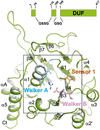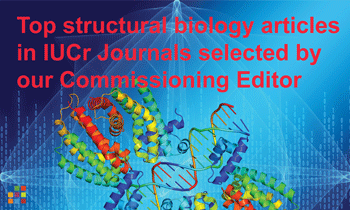issue contents
June 2024 issue

Cover illustration: Pillar data-acquisition strategies for cryo-electron tomography of beam-sensitive biological samples [Parkhurst et al. (2024), Acta Cryst. D80, 421–438]. In order to achieve isotropic resolution in the presence of electron-beam damage to the specimen in cryo-electron tomography, an n-helix tilt scheme is described and simulated, which uses overlapping and interleaved tilt series to maximize the use of a pillar geometry.
research papers
The structure of ketohexokinase C in complex with a natural substrate and product ADP mimicking the Michaelis complex is reported and a comparison with other structures with and without ligands shows that it undergoes a conformational change that places the enzyme in a catalytically competent form. These findings will be of interest to those in the areas of enzymology, enzyme structure–function relationships and drug discovery.
The biochemical and X-ray crystallography-based characterization of human dihydroorotate dehydrogenase (DHODH) in complex with a potent antiproliferative agent is presented. The peculiar conformation of a protein loop involved in the gating mechanism at the cofactor-binding site reveals a new binding modality of the tested compound that will contribute to a reappraisal of the inhibition of human DHODH.
Open  access
access
 access
accessThe crystal structure of the DUF domain of EccC5 from Mycobacterium tuberculosis, a degenerated ATPase domain with potential implications in the opening and closure of the membrane pore in the M. tuberculosis ESX-5 secretion system, is reported.
PDB reference: DUF domain of EccC5 from Mycobacterium tuberculosis, 8rin
Open  access
access
 access
accessThe relation between template size, shape and angular sampling is systematically evaluated to identify ribosomes in a ground-truth annotated data set. The findings are discussed in a theoretical framework.
Open  access
access
 access
accessPillar data-acquisition strategies for cryo-electron tomography of beam-sensitive biological samples
An n-helix tilt scheme for cryo-electron tomography of pillar-shaped samples is described and simulated, allowing the entire pillar volume to be reconstructed as a single unit. Three related tilt schemes to enable the collection of the most isotropic information across all spatial frequencies are also evaluated.
Open  access
access
 access
accessThe integration of Capsules within the SBGrid software-management platform marks a pivotal advancement in addressing the challenges of scientific software distribution, dependency management and computational reproducibility.
Open  access
access
 access
accessAnomalous scattering and PanDDA were employed to determine the binding orientation(s) of novel planar and low-occupancy fragment hits containing sulfur and/or halogen atoms that bind to SARS-CoV-2 nsp1. This approach was validated for these challenging-to-fit fragments with an anomalous data-collection strategy designed to mitigate radiation-damage effects, which are known to particularly affect halogenated fragments due to their higher X-ray absorption cross sections.

 journal menu
journal menu

























